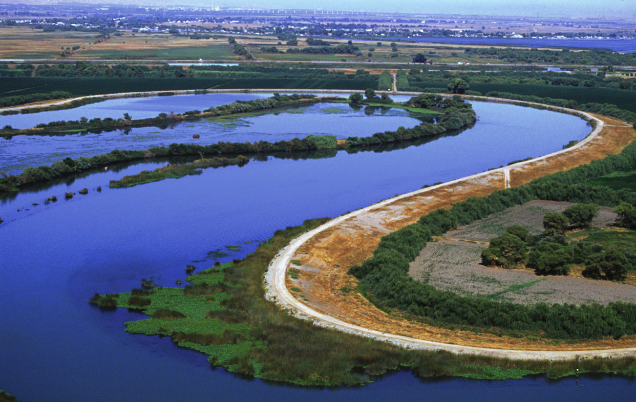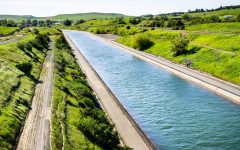
California Bay Delta water (Photo: USGS.gov)
Ringside: How Many People Will Water From the Delta Tunnel Support?
Californians need suburban expansion, so they can live in livable homes
By Edward Ring, July 31, 2024 3:33 pm
 According to the California Department of Water Resources (CDWR), “The Delta Conveyance Project would yield about 500,000 acre feet of water per year, which is enough for about 5.2 million people.”
According to the California Department of Water Resources (CDWR), “The Delta Conveyance Project would yield about 500,000 acre feet of water per year, which is enough for about 5.2 million people.”
Let’s put that into perspective. Over the past ten years, on average, California’s farms have required 33.4 million acre-feet per year, and California’s cities have required 7.9 million acre-feet per year. So increasing California’s overall water supply for farms and cities by 500,000 acre-feet will add 1.2 percent to our water supply. The official estimated total project cost for the Delta Conveyance is $20 billion.
But is 500,000 acre-feet really enough water for 5.2 million people? Since one acre-foot is equal to 325,851 gallons, then 500,000 acre-feet is equal to 162.9 billion gallons, which over a year would equal 446 million gallons per day. Spread that among 5.2 million people, and you’ve got 86 gallons per day per person to work with. Is that enough?
If we are all destined to live in apartments without yards, and limit our indoor water use to 42 gallons per person per day, an 86 gallon allocation is ample. You might even call it generous. But in spacious California, a state that is only 5 percent urbanized, if we want to allow people to live in detached homes with yards, 86 gallons per person is going to be a squeeze.
The sources and uses of water in California are reported by CDWR in their Water Plan documents. For 2011-2015 refer to page 1-4 the 2018 Update, and for 2016-2020 refer to page 2-8 of the 2023 Public Review Draft. Among the reported categories of total statewide water use, they report “residential-interior” and “residential-exterior,” measured in millions of acre-feet (MAF).
Here are the numbers for 2020: a total of 3.0 MAF for residential indoor water use, and 1.9 MAF for residential outdoor water use. If we assume all of California’s 39.5 million residents were being measured here (that’s unlikely, which means these calculations are going to understate per capita urban use), these usage totals equate to 67 gallons per person per day of indoor water use, and 43 gallons per day of outdoor water use.
This means that for 500,000 acre-feet to serve 5.2 million people, total per capita household water use would have to drop by 22 percent, from 110 gallons per day to 86 gallons per day.
We ought to be rejecting this scenario entirely. One of California’s most informed critics of the “stack and pack,” anti-suburban, environmentalist-driven regulatory bias that drives California policies today is the formidable Jennifer Hernandez, a San Francisco based land use attorney who in 2021 published a must-read article “Green Jim Crow, How California’s Climate Policies Undermine Civil Rights and Racial Equity.”
In this expansive, scrupulously documented indictment of out-of-control environmentalism, Hernandez specifically addresses why home ownership and upward mobility is now denied to most Californians, writing, “The state’s climate policies now directly impede this critical homeownership goal by demanding that the vast majority of new housing be built in the state’s most expensive urban infill locations as high-density, multifamily, and almost invariably rental projects.”
There is only one way to bring per capita urban water use down to 85.8 gallons per day, and that is through escalating restrictions on the construction of single family detached homes with lots. As Hernandez describes, that process is well underway, and it harms the people that the “climate justice” community purports to care about the most. As for the detached homes with lots that are still getting built, they are on lots so small there isn’t room for landscaping of any type, much less the large trees that beautify California’s legacy suburbs.
Policies of urban containment and densification are wrong on every level. There is plenty of land. Building new homes for ten million new residents on quarter acre lots, with four person households, and allocating an equivalent amount for schools, parks, roads, retail and commercial areas would only consume 1,953 square miles. This would only increase California’s urban footprint from 7,800 to 9,700 square miles, i.e., from 5.0 percent to 6.2 percent of all land in the state.
There is also plenty of water. In the winter of 2023, over 27 million acre-feet (ref. Station ID “DTO” and Sensor number 23) flowed through the Delta and out to the Pacific. In an average year, 10 million acre feet of water flow through the Delta and out to sea beyond what is necessary for ecosystem health. We need to build new facilities that can divert and store the excess water that feeds the Delta and flows through the Delta during winter storms, and if we did, California’s farmers and urban residents would never experience water scarcity again.
We should be planning to supply our urban water consumers at least 10 million acre-feet per year, instead of relentlessly cramming down total urban water use through policies of rationing – policies that include a legislative war on single family homes. If you live on a home with a reasonable sized yard, check your water bill. Residential customers are usually billed by the “CCF,” where one CCF is 100 cubic feet, or 748 gallons. It’s not unusual for a single family dwelling with outdoor landscaping to have summertime outdoor water use amounting to hundreds of gallons per day. Before ripping all those plants out of the ground, have a look at the neighborhood’s “xeriscapes.” Focus on the ones that are at least two or three years old. Observe the flaking plastic underlayment poking up through an inadequate layer of decorative rocks. Examine the prolific weeds that have withered into three foot high dead tinder. Is this pretty? Could your children play on these surfaces? Then consider the heat island impact of these virtuous experiments.
Water is life. Prolific, extravagant, water wasting urban landscaping is life. Californians need suburban expansion, so they can live in livable homes. As noted, ten million people living in new suburbs would not occupy more than a small fraction of California’s 155,779 square miles of land. But it’s going to require more water. A lot more water. And doing that is the obligation of our state government. Not rationing.
The Delta Tunnel, at a cost of $20 billion (it will probably cost far more), has only one compelling reason to be built. If an earthquake devastates levees in the Delta, the below-sea-level islands will fill up with salt water, preventing existing Delta systems from pumping fresh water down to Southern California. That is reason enough for its construction. But based on current habits of consumption, 500,000 acre feet will supply 4 million people, not 5.2 million people. And if we allow more people to build homes on reasonably spacious lots, big enough to accommodate the same grass and shrubs and trees that we grew up enjoying, 500,000 acre feet might only be enough to supply 3 million people.
Water policy in California should be focused on how to safely harvest, treat, and deliver additional millions of acre feet to California’s cities. The Delta Tunnel is a hedge against catastrophic earthquakes. But we need much more.
- Ringside: What is the Future of California’s Republican Party? - December 31, 2025
- Ringside: CA GOP Just Blew $46 Million for Nothing – Here’s How They Can Avoid Repeating That Mistake in 2026 - December 24, 2025
- Ringside: Will the Delta Pumps Operate at Capacity this Winter? - December 18, 2025





The Delta Tunnel will become another BS Train to nowhere, a project designed to never be finished, just cost more and more each year. I suspect the true reason is to create a reverse flow of salt water into the delta farmland water table to kill it for farming, and make it available for Bay Area urban sprawl.
What would the project cost if Elon Musk’s Boring Co. built it without prevailing wages?